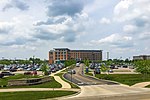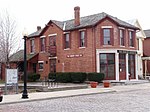Boonshoft School of Medicine
All pages needing cleanupHealthcare in Dayton, OhioMedical research institutes in the United StatesMedical schools in OhioResearch institutes in Ohio ... and 1 more
Universities and colleges in Dayton, Ohio
The Boonshoft School of Medicine, also known as Wright State University School of Medicine, is an accredited medical school at Wright State University. It is located in Dayton, Ohio, United States and serves the Miami Valley region of southwestern Ohio. The school was renamed in 2005 in honor of Oscar Boonshoft who gifted $28.5 million to further medical education, research, and scholarship.
Excerpt from the Wikipedia article Boonshoft School of Medicine (License: CC BY-SA 3.0, Authors).Boonshoft School of Medicine
Colonel Glenn Highway,
Geographical coordinates (GPS) Address Nearby Places Show on map
Geographical coordinates (GPS)
| Latitude | Longitude |
|---|---|
| N 39.777935 ° | E -84.06176 ° |
Address
Colonel Glenn Highway 3000
45324
Ohio, United States
Open on Google Maps








